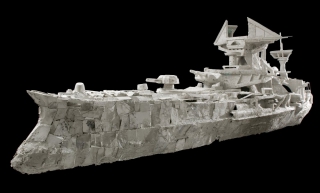“I am a cheerful pessimist”
As it had been announced here earlier, Alexander Seiler is presenting some of his fascinating objects in the gallery Schultz Contemporary Berlin. The large-format works of the exhibition “Panthersprung” (“Panther’s Leap”, 28 February – 18 April 2009) make a visit worthwhile.
All of the three objects shown are ships. At first glance, the some 5 metres long works made of plaster could be normal warships: slender silhouette, gun turrets, superstructure with command bridge. Soon, however, the beholder will notice that the artist knew to create something new by adding architectural elements:
The “Barke des Oligarchen – Kenotaph” (“The Oligarch’s Barque – Cenotpah”, plaster, 2008, 135 x 85 x 465 cm, 16,000 €) is not really a barque at all: the title ironically reflects the “yachts” of all those economy barons that adopted the size of a veritable aircraft carrier. The title’s second part may refer to the state or even our social system: a cenotaph to remind of a once glamorous time that is entirely gone. The boat with the extended hull of a cruiser is, according to Seiler, “first of all, a ship of state” on which one can find several issues “that push the state”:1 a factory building with its typical shed roof forms the centre, an obelisk serves as mast while looking like a smokestack of the period of promoterism. The massive vent (by its circumference) is short, as it had been capped or demolished, like so many factories’ chimneys. In front of it, a large superstructure with Doric columns on its sides, leading to various interpretations: it may be a location to pay religious obeisance – or it could be a market or a stock exchange, locations to honour money. A pompous government building could be set on the waist, too, whose columns find rest between superstructural parts that remind of the pinnacles of castles. Time has left its marks: the factory is run down and ruined, the ship is ailing.
The “Mutterschiff” (“Mothership”, plaster, 2008, 110 x 85 x 495 cm, 16,000 €) is, however, a clear-cut battleship in its appearance: the main armament consists of triple turrets whose barrels are made of columns: adjusted unevenly, showing to the ground if not broken. The two vents are likewise columns, while the complex, quirky superstructure is warpedly braving the ocean: the ship seems to have fought quite some battles – now, one would like to see it rather in a dockyard than on open sea. Like the other ships, it is not built entirely symmetric: here is a sad boat hanging from a davit, and there weird superstructures had been added. Equally interesting is the shipborne aircraft, resting on a short catapult: it has no buoyancy chambers for a splashdown. Using it would thus become a flight without return.
The ship “Panthersprung II” (“Panther’s Leap”, plaster, 2004, 75 x 65 x 475 cm, 14,000 €) refers with its eponymous name to the “Panthersprung nach Agadir” of 1911, the “Agadir Crisis” or “Second Morocco Crisis”, an example of imperial “gun boat diplomacy”, in which aggressive gestures were used to gain power or influence. This attempt did thoroughly fail, and this ship looks equally battered with its sad and impotent barrels made of columns and the triangular gable over the command bridge that reminds of a temple. The superstructures appear to be battered down, the stretched hull lies slantly. The hull’s armour plates remind again and again of an old and fissured skin.
Seiler regards the “occident’s downfall” as a “fitting connotation that I quite followed, too”. He works with plaster, “sort of a primordial substance, somewhat like the primordial soup”. The material is perfectly suited for the works: not much is left from the once-bright whiteness and its smoothness. The works express caducity and decay, as if the ships had been afloat since thousands of years. Will they ever be refurbished, or will they be salvaged – or do they rather await their sinking? The architectural elements consistently refer not only to history, but also and especially to culture: has its time come, too? What are the values that had been defended or maybe carried to battle as high-handedly as assured of victory?
“What leaves a nasty taste in my mouth”, Seiler said, “are those do-gooder-fascists, those hypocritical salesmen of indulgences in their whole dishonesty who never show any true effort to gain truth or enlightenment, but whose sole purpose is to prove their own morality.” Currently, he works on a “Nuremberg Chess”: “I think that will be a fair, provoking thing.” There he is again, the cheerful pessimist.
Alexander Seiler: “Panthersprung”
28 February -18 April 2009
Schultz Contemporary Berlin
Mommsenstr. 34
10629 Berlin
Tu-Fr 1000-1900h, Sa 1000-1400h
Alexander Seiler will have his next exhibition at Archiv Massiv gallery at the Spinnerei in Leipzig, shown from 30 April 2009 onwards.
- All quotes: interview with the author on 28 February 2009; translations by the author. ↩





